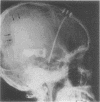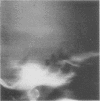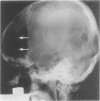Abstract
A case of spontaneous nontraumatic cerebrospinal fluid rhinorrhoea secondary to aqueductal stenosis is reported. The patient required direct repair of the fistula after the insertion of a ventriculoperitoneal shunt for aqueductal stenosis. We emphasise an unusual complication of tension pneumocephalus in a case where the shunt patency had been substantiated. Intracranial pressure fall due to the siphon effect in the ventriculoperitoneal shunt tubing in the erect position might be responsible for ingress of an excessive amount of air.
Full text
PDF



Images in this article
Selected References
These references are in PubMed. This may not be the complete list of references from this article.
- Greenblatt S. H., Wilson D. H. Persistent cerebrospinal fluid rhinorrhea treated by lumboperitoneal shunt. Technical note. J Neurosurg. 1973 Apr;38(4):524–526. doi: 10.3171/jns.1973.38.4.0524. [DOI] [PubMed] [Google Scholar]
- Jones H. M. Cranial pneumatocele. Proc R Soc Med. 1970 Mar;63(3):257–262. doi: 10.1177/003591577006300319. [DOI] [PMC free article] [PubMed] [Google Scholar]
- Kaufman B. The "empty" sella turcica--a manifestation of the intrasellar subarachnoid space. Radiology. 1968 May;90(5):931–941. doi: 10.1148/90.5.931. [DOI] [PubMed] [Google Scholar]
- Little J. R., Houser O. W., MacCarty C. S. Clinical manifestations of aqueductal stenosis in adults. J Neurosurg. 1975 Nov;43(5):546–552. doi: 10.3171/jns.1975.43.5.0546. [DOI] [PubMed] [Google Scholar]
- Little J. R., MacCarty C. S. Tension pneumocephalus after insertion of ventriculoperitoneal shunt for aqueductal stenosis. J Neurosurg. 1976 Mar;44(3):383–385. doi: 10.3171/jns.1976.44.3.0383. [DOI] [PubMed] [Google Scholar]
- Magnaes B., Nornes H. Traumatic tension pneumo-hydrocephalus. The intracranial pressure pattern and the pathogenetic factors. Acta Neurochir (Wien) 1972;27(1):17–27. doi: 10.1007/BF01402169. [DOI] [PubMed] [Google Scholar]
- Nishikawa M., Karasawa J., Kamada K., Kikuchi H., Makita Y. [Non-traumatic cerebrospinal fluid rhinorrhea associated with aqueductal obstruction]. No To Shinkei. 1972 Feb;24(2):173–177. [PubMed] [Google Scholar]
- North J. B. On the importance of intracranial air. Br J Surg. 1971 Nov;58(11):826–829. doi: 10.1002/bjs.1800581106. [DOI] [PubMed] [Google Scholar]
- Obrador S. Primary non-traumatic spontaneous cerebro-spinal fluid rhinorrhea with normal cerebro-spinal fluid pressure. Schweiz Arch Neurol Neurochir Psychiatr. 1972;111(2):369–376. [PubMed] [Google Scholar]
- Ommaya A. K., Di Chiro G., Baldwin M., Pennybacker J. B. Non-traumatic cerebrospinal fluid rhinorrhoea. J Neurol Neurosurg Psychiatry. 1968 Jun;31(3):214–225. doi: 10.1136/jnnp.31.3.214. [DOI] [PMC free article] [PubMed] [Google Scholar]
- Rovit R. L., Schechter M. M., Nelson K. Spontaneous "high-pressure cerebrospinal rhinorrhea" due to lesions obstructing flow of cerebrospinal fluid. J Neurosurg. 1969 Apr;30(4):406–412. doi: 10.3171/jns.1969.30.4.0406. [DOI] [PubMed] [Google Scholar]
- Schechter M. M., Rovit R. L., Schachter J. M. Rhinorrhea and hydrocephalus. Observations on spontaneous cerebrospinal fluid fistulae in patients with increased intracranial pressure. Acta Radiol Diagn (Stockh) 1969;9:101–116. [PubMed] [Google Scholar]





